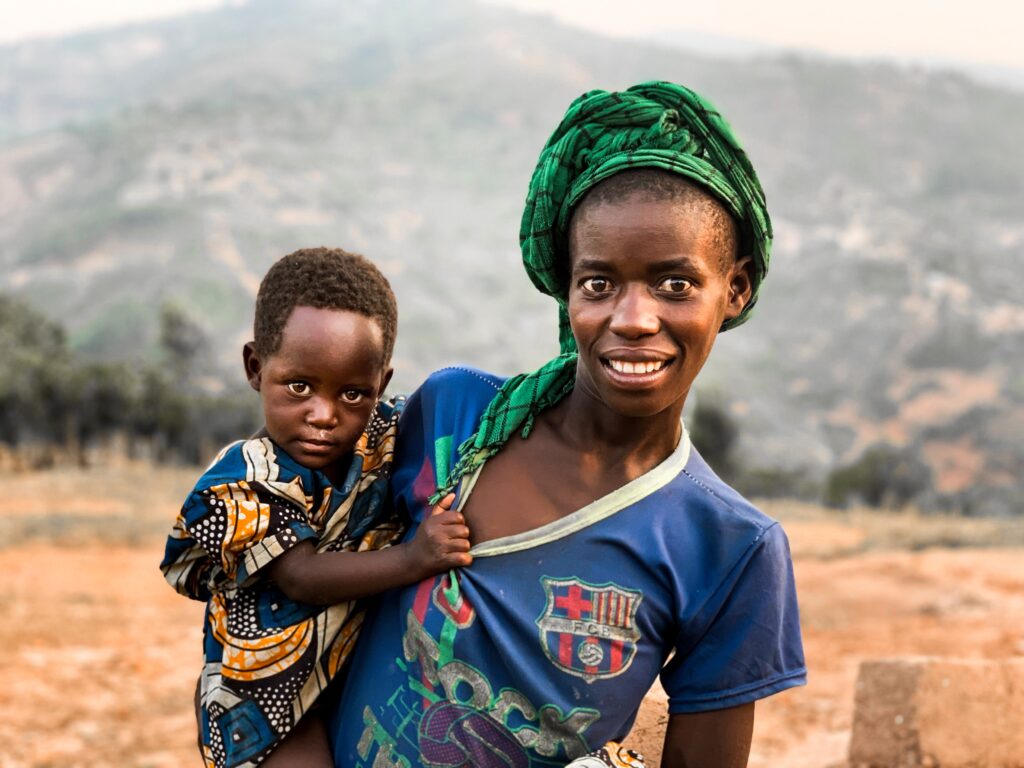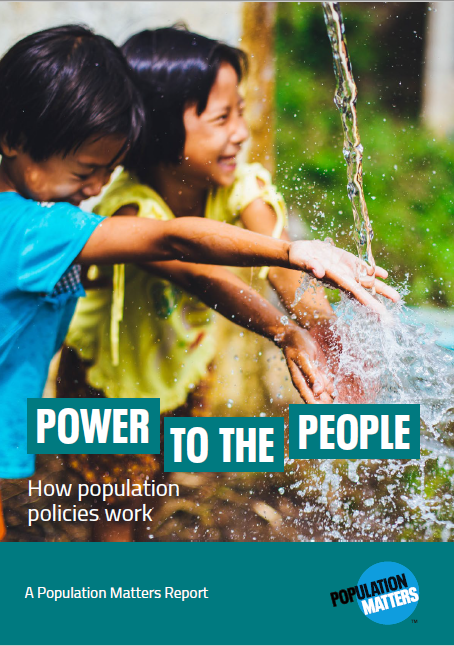
People power not state power – population policies that work
Across the world, population growth is slowing, family sizes are shrinking, and individuals, communities and our environment are reaping the rewards. In many cases that has come about because governments have introduced policies to end population growth. Often, people assume “population policy” to mean “population control”, such as China’s one-child policy. The reality is far different – policies which gave people choice and improved their lives. Our new report looks at a good news story that is rarely told.
Published to mark World Population Day 2023, Power to the people: how population policies work reveals the reality of “population control”. Unnoticed, and for decades, governments and other agencies across the world have been implementing policies to give people the opportunity to do what they wanted to do: have smaller families. By clearing away the obstacles and addressing the circumstances that leave people with few options other than to have many children, they have quietly brought about benefits that are not the product of the exercise of power, but the benefits of empowerment.
Despite the high profile of horrendous abuses such as the one-child policy and forced sterilisation in India in the 1970s, they are aberrations, not the norm. As the United Nations has put it:
Some population policies, especially in past decades … sometimes [used] coercion to ensure widespread adoption of family planning practices … However, most national population policies were not coercive.
The reality is very different:
In most high-fertility countries, governments have put in place policies and programmes that contribute to lowering fertility levels through various mechanisms, including by reducing women’s unmet need for family planning, by raising the minimum legal age at marriage, by integrating family planning and safe motherhood measures into primary health care, or by improving female education and employment opportunities.
United Nations Department of Economic and Social Affairs (UNDESA)
What works
Power to the people explains how measures such as health care and education lead to smaller families, and in particular how gender equality creates opportunities and very often the desire to reduce family size. It examines the benefits of tackling poverty, but also shows how reducing population growth helps lift people from poverty. It also, of course, emphasises the central importance of ensuring that people have access to and are free to use contraception. Illustrating these points, the report examines four case studies.
Thailand: imagination and dedication
The story of Thailand’s successful population policy has been told many times but has not yet entered the public consciousness. With a total fertility rate (TFR, broadly equivalent to average family size) of six in 1970 and a population growth rate of 3%, the government launched a population programme to ensure that people could access contraception and take advantage of using it. They improved health facilities and access, education and female empowerment.

Accompanying their work on these basics was an imaginative and popular communications campaign, led by the charismatic Mechai Viravaidya, also known as Mr Condom. From having police distribute condoms (the “Cops and Rubbers” campaign) to opening the Cabbages and Condoms restaurant chain, Mr Condom put contraception squarely in the public eye. Today, Thailand’s TFR is 1.3, and it has enjoyed economic growth the envy of its neighbours, arising, according to the World Bank, from “a rapid demographic transition as a result of birth control campaigns, rising prosperity and delayed childbearing for education and careers.”
Kerala: putting it all together
India has a dark history of population control, and while it has made significant strides in protecting human rights, there are still concerns over its “population control” approach. Those include policies in some individual states discriminating against families with more than two children – see our 2022 report.
The southern state of Kerala is an exception, however. During the 1950s, Kerala’s population was growing faster than that of any other Indian state, but by 1987 it had become the first state to reach a “replacement level” fertility rate (ie one at which parents “replace” themselves but population stops growing). Kerala took advantage of relatively high levels of female education for the time and achieved such rapid birth rate decline – one of the fastest in South Asia – through early investment in women’s empowerment, healthcare, and non-coercive family planning.
The state has reaped the benefits. In 1978, when its family planning programme was already well underway, Kerala’s per capita income was only $80, far less than the Indian average. However, after slowing its population growth, Kerala has had a much more rapid decrease in poverty than other Indian states. Today, it is one of India’s richest states and ranks first in human development indicators.
Rwanda: from trauma to empowerment
Rwanda, the most densely populated country in Africa, had one of the world’s highest fertility rates in the 1980s, with each woman having on average 8.5 children in her reproductive life. Reducing population growth with the primary aim of promoting economic development and reducing poverty became a key government target.
In 1994, however, the Rwandan genocide took place, with a million people murdered, in a country with a population of just eight million. Following the genocide and an exodus of millions of refugees, fertility rose amid social chaos and reluctance to see population shrink further. In 2003, the country’s National Policy for Sustainable Development identified the importance of addressing population growth as part of a holistic programme for sustainable development, including ensuring universal education for all children, and equal economic opportunity for men and women.

Between 2000 and 2010, “ideal family size” in Rwanda dropped from 4.9 to 3.3, while between 2005 and 2020, contraceptive use among married women increased from 17% to 64%. Its TFR of 3.7 is the lowest in the region. Child and maternal mortality have dropped significantly, and Rwanda was one of only two countries in sub-Saharan Africa to achieve the Millennium Development Goals for health.
There is much work still to do. Many local health facilities are church-provided, and, in turn, often reluctant to embrace family planning and hostile to abortion. A 2022 bill to allow girls between 15 and 18 to legally access contraception was rejected in parliament.
Despite the obstacles, and the challenges remaining for this tiny country, categorised as among the world’s Least Developed, the achievements have been remarkable.
Costa Rica: paving the way for progress
In the past 60 years, Costa Rica has undergone a remarkable transformation. Its GDP per capita grew from $380 to over $12,000, life expectancy climbed from 60 to 80 years, and the fertility rate fell from nearly seven to less than two. Costa Ricans now enjoy much higher standards of education and one of the world’s most effective primary healthcare systems. Nature, too, is flourishing: after years of intensive logging, Costa Rica became the first country to reverse deforestation, and now leads the world in renewable energy use.
In the early 1960s, forestry professor Henry Tschinkel and his colleague Alberto González noticed a link between Costa Rica’s rapid deforestation and the extremely high unmet need for contraceptives among Costa Rican women. Convinced that slowing population growth would simultaneously lift families out of poverty while also relieving pressure on Costa Rica’s natural resources, González founded the Costa Rican Demographic Association to start promoting and providing family planning services.
Despite never articulating an explicit population policy, the Costa Rican government also played a critical role. Through its family planning programme, the government made contraceptives much more accessible, particularly to rural and low-income communities. Local churches helped distribute contraceptives while minister Padre Carlo hosted a radio show called Dialogo, in which he challenged the cultural hesitancy to discuss sex and promoted contraceptive usage.
Through mass communication and home visits – particularly important in rural areas – nurses, social workers, and priests explained to couples that having fewer children would enable them to save more money and enjoy more leisure time. Costa Rica now has Latin America’s highest rates of contraception usage – 84% – and one of the region’s lowest birth rates.

Costa Rica’s progress in demographic terms is remarkable, but that should not obscure remaining challenges. Socially and economically, progress has stalled in some respects, with inequalities continuing to impact on the health and rights of the most vulnerable.
While it would be a mistake to ignore its remaining and significant problems, in a 2021 evaluation, Costa Rica ranked as the 16th happiest place on Earth. Like every country, Costa Rica’s story is multi-faceted, and no one factor has driven the gains it has made. It nevertheless serves as an excellent example of how addressing population growth paves the way for women, children, and nature to flourish.
The picture today
These examples are far from the only ones, with countries from South Korea to Bhutan to Kenya having made great strides, as the report describes.
According to the UN’s 2021 World population policies report, in 2019, nearly three quarters of governments had policies related to fertility: 69 governments to lower it (including in half of all developing countries), 55 to raise it and 19 focused on maintaining existing levels.
Population Matters’ groundbreaking report, Welcome to Gilead, details how some policies to raise fertility are linked to human rights abuses. Evidence of systematically abusive policies intended to limit fertility is not easy to find beyond India, and while undoubtedly there will be failings and concerns arising under the radar, that should not obscure the positive reality that the majority of population policies are voluntary, empowering and enhance lives.
Let’s spread the good news.


